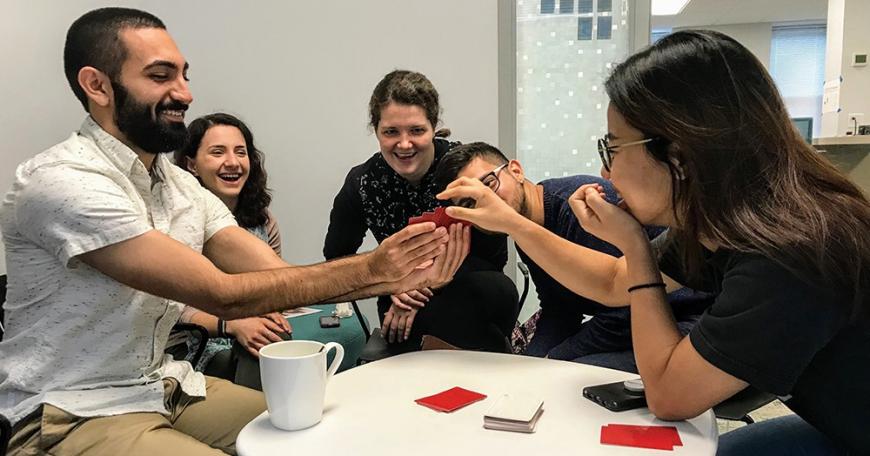
Teaching teachers the science of learning and development
A white paper published this fall by MIT’s Playful Journey Lab and High Meadows Graduate School of Teaching and Learning (formerly the Woodrow Wilson Graduate School of Teaching and Learning) suggests concrete steps teacher education programs can take to integrate key findings from the science of learning and development (SoLD) into their curriculum, paving the way for a new generation of educators who can flexibly draw from SoLD research in their practice and drive meaningful change at the classroom level.
When the High Meadows Graduate School launched in 2018, teacher candidates engaged with SoLD through a single discrete module completed towards the end of the program, though they were given the option to take part in stand-alone learning experiences earlier on in their training. Following concerns about a lack of program coherence during the graduate school’s inaugural year, a group of faculty and staff recommended that the program designate “core competencies” central to effective teaching. The School’s full faculty, staff, and administration, along with designers and researchers from the Playful Journey Lab at MIT Open Learning, worked to select a handful of core competencies from among the 20 that teacher candidates are required to demonstrate. When Grounding Practice in the Science of Learning & Development was identified as one of five core competencies, SoLD became a pillar of the program.
The next step was to redesign the program in order to support the teacher candidates at the High Meadows Graduate School in learning about, practicing, and demonstrating SoLD. Design researcher Dr. Meredith Moore gathered a team consisting of a learning scientist and a learning designer with knowledge of the curriculum as a whole. This interdisciplinary group had the mix of skills and knowledge necessary to develop a plan suited for the specific context of the Graduate School. The team regularly provided updates to and sought feedback from the faculty and staff throughout the redesign process.
The team started by determining which research on learning and development to prioritize, leading them to the work of the Science of Learning and Development Alliance. Begun in 2016, the SoLD Alliance is an interdisciplinary initiative to synthesize knowledge from multiple disciplines on the science of learning and development to address persistent issues of inequity and underperformance in the US education system. By communicating the science of learning and development in relevant and actionable ways, SoLD practitioners aim to use their insights to provide better learning experiences for all children. The SoLD Alliance’s work employs a relational developmental perspective and a growing body of research encompassing a wide variety of factors that shape children’s learning and development, including environmental factors, relationships, and learning opportunities, along with internal cognitive, psychological, physical, social, and emotional processes. This perspective and work were found to be consistent with the High Meadows Graduate School’s conception of the goals of schooling and served as the foundation for the SoLD framework used in the program redesign.
The redesign will help teachers-in-training dispel preconceptions of what does and does not work in a learning environment. “Too much of what occurs in schools runs counter to SoLD research findings,” says Moore. “Most new teachers probably experienced ineffective pedagogy as students and continue to witness ineffective pedagogy from colleagues. By emphasizing SoLD, teacher education programs help teacher candidates to reevaluate what they think they know about learning. This prepares them to critically assess different pedagogical models, including those used by their colleagues, and to make research-based instructional choices that are better for their students.”
In a white paper resulting from their experience, the implementation team argues that integrating SoLD findings into their curriculum has led to a proactive new group of incoming teachers who will be positioned to apply these lessons in their own classrooms. The paper also offers key takeaways for other teacher preparation programs interested in SoLD, in the hope that processes and materials developed during this project can serve a design resource.These takeaways cover the entire implementation process: from launching the process, to mapping the SoLD landscape, to selecting SoLD research, and finally to integrating SoLD into the curriculum. Specific takeaways from the final part of the process include:
- Develop a detailed proposal for integrating SoLD concepts across the teacher education curriculum. Seek and incorporate feedback from the faculty.
- Develop and compile resources on the research as well as implications for practice that can be used to design and/or revise course content. Resources should be educative for faculty as well as for teacher candidates.
- Provide multiple opportunities for teacher candidates to consolidate their understanding of SoLD.
- Collaborate with clinical faculty on a coordinated approach to integrating SoLD into teacher candidates’ fieldwork.
- Use an assessment approach that evaluates teacher candidates’ understanding of the research on learning and development, their use of research-based strategies, and their ability to evaluate SoLD-based strategies in relation to the learners in the classroom and larger sociopolitical and historical contexts.
Adapted from a story originally published at https://playful.mit.edu/ on October 26, 2020.

